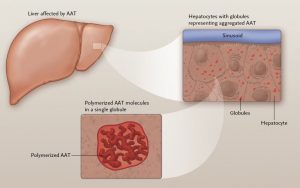Alpha-1 liver disease occurs when abnormal Z-type AAT proteins build up within liver cells. Some of the AAT proteins link to other AAT proteins in a process called polymerization. These polymers can form large or small clusters that damage the liver cell.
Download Alpha-1 Liver Disease – Causes, Treatments, and More as a PDF.

Silverman et al. NEJM
Do all Alphas develop liver disease?
Some Alphas never develop liver disease. Sometimes these people have an unusual form of Alpha-1 — the Null deficiency. We assume they don’t get a buildup of abnormal AAT protein because they don’t make AAT in their livers. Other individuals seem to handle the AAT polymers without getting scarring in the liver.
About 2% of children born with Z-type Alpha-1 develop liver failure and need a liver transplant before age two. Research suggests their liver’s inability to handle protein build-up leads to damage.
Most infants born with two Z genes have abnormal liver function tests during this same time period. But, if they don’t develop severe disease, their tests usually return to normal as they get older.
Adults and Alpha-1 liver disease
Most adults with Alpha-1 won’t develop significant liver disease. If liver disease does occur, it is often very mild and chronic. It may remain stable for years. However, some adults develop liver disease suddenly and quickly need a liver transplant. So far, there’s no way to predict whether you’ll have mild or severe liver disease.
Studies have shown that people over 65 with Alpha-1 have liver scarring that can be seen under the microscope. This is true even when their liver function tests are normal. This suggests that all or most people with Alpha-1 have ongoing, low levels of liver injury throughout their lives.
Fortunately, your liver can tolerate this type of injury and still function normally.
We don’t know all the reasons why some people have higher levels of liver damage. But we know that environmental factors and genetic factors play a role.
Treatments for AAT associated liver disease
There is no specific treatment for Alpha-1 liver disease. But there are many treatments that help the outcome of all liver diseases that can be used. They focus on preventing complications from chronic liver disease. And, if liver problems arise, they treat them quickly.
Lifestyle risk factors
Obesity is the #1 lifestyle risk factor for liver disease. The “metabolic syndrome” occurs when obesity causes diabetes, high blood pressure, and increased cholesterol. The result is a fatty liver that is not tolerated well in Alpha-1.
What does the future hold?
This is an exciting time for new drug therapies that target Alpha-1 liver disease. Drugs are in clinical trials that stop AAT production in the liver. Other drugs help to get AAT out of the liver cell. At the present time, these treatments are only available through clinical trials.
Researchers are also working on diagnostic tests to help detect liver damage earlier.
For more in-depth information on this topic, please visit the Big Fat Reference Guide (BFRG). If you are enrolled in AlphaNet’s Subscriber Portal, you can access the BFRG here.
Resources
For additional information about Alpha-1 and Alpha-1-related disease check out these resources:
Alpha-1 Foundation
www.Alpha1.org
877-228-7321
AlphaNet
www.bfrg.alphanet.org
800-577-2638
American Liver Foundation
www.liverfoundation.org
866-455-4837
UNOS – United Network for Organ Sharing
unos.org
800-292-9548
NIDDK – National Institute of Diabetes and Digestive and Kidney Diseases
www2.niddk.nih.gov
301-451-4524
800-891-5389 (digestive)
Download Alpha-1 Liver Disease – Causes, Treatments, and More as a PDF.

